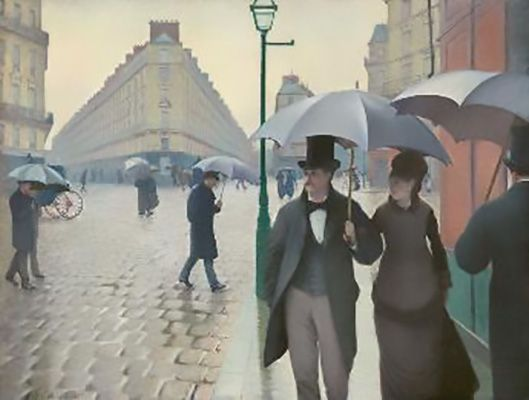Baroque Blog
David with the Head of Goliath, 1610
This painting below was one I found from this era that I liked a lot. It was painted by Caravaggio in 1610. The story behind this painting makes the work of art so much more interesting to me. In an article about the artist and this work it stated "On May 1606 Caravaggio was accused of murder and fled from Rome to distant lands (Naples, Sicily, Malta) to escape the price that had been placed on his head. His self-portrait as Goliath's severed head, held by David his executioner, was sent to the papal court in 1610 as a kind of painted petition for pardon. In fact pardon was granted, but did not reach Caravaggio before he died in Porto Ercole." (Mattise, 2009). I think the story fits perfectly with the dark tone of the painting and really feeds into the piece itself. The dark background contrasted with the eerie image of a man holding a severed head really sets a mood in this work. Knowing the story behind this painting really elevated my interest on this one. Not to mention I have seen this work before on an album cover from an album by Westside Gunn named Pray for Paris. I have attached the cover at the very bottom. Wikipedia helped me find out more about the cover stating "The cover was created by Virgil Abloh using Caravaggio's David with the Head of Goliath" (Wikipedia 2021).
I think this story and painting connect with the rise of the merchant class of this period. His story spread across the region and only boosted his popularity as an artist. I think this has to do with the merchant class recently becoming popular with buying art pieces. As we know art was for the most part reserved for the high class up until this period. As art broke into the merchant class more people became aware of the story of Caravaggio and his works. In an article from Britannica I found this quote "He committed murder and violent assault while at the peak of his success in Rome and consequently spent much of his later career—when he also created many of his most-compelling works—as a fugitive from justice" (Britannica, 2019). His works were real and rugged. They highlighted the humanity of even the highest biblical figures and I think that really spoke to this class of people. It only helped him in the end and cemented him as a giant of this time period of art.
References:
“David with the Head of Goliath, 1610 by Caravaggio.” Henri Matisse, 2009, www.caravaggio.org/david-with-the-head-of-goliath.jsp.
“Pray for Paris.” Wikipedia, 27 Aug. 2021,
en.wikipedia.org/wiki/Pray_for_Paris.
Graham-Dixon, Andrew. “Caravaggio | Italian Painter.” Encyclopædia Britannica, 4 Feb. 2019, www.britannica.com/biography/Caravaggio.





Matt your baroque art choice immediately caught my eye and evoked the emotional response, “What the h!@#!” I think the most striking observation for me is from my initial viewing, this art was shocking, and I did not make the religious connection, which I think is usually obvious. Thank you for providing the history of this piece. Knowing that the decapitated head is Caravaggio’s self-portrait adds to this piece’s shock value.
ReplyDeleteThis piece encapsulates the baroque characteristics of drama, emotional exuberance, and tenebrism. The severed head and dripping blood convey drama and evoke an emotional response from the viewer. The darkness is effective in adding to the drama. I like how the negative space is dark and the light reveals David front and center. The light illuminated his hand holding the severed head drawing the viewer’s eyes to the lower, right corner. I love the realist, baroque aesthetic. This painting is the epitome of a humanlike depiction of religious figures.
The extreme contrast of light and shadow in this piece adds to the grandeur of this piece and the deep color pattern. Goliath’s hair is almost the same color as the shadow surrounding David and Goliath. Same with David’s hair. It blends right into the shadows. The dark brown pants contrast nicely against the silver, metal sword. The light illuminating skin tones reveal muscle tone and facial expressions.
I honestly, think this is a very incredible piece. Caravaggio seemed to have broken so many art stereotypes, his selling artwork to the merchant class and his technique. I agree with you, his works are real and rugged and appealed to the people.
Hello Matt, great choice in artwork for this period. Just by the shortest glance, I can tell that this is a Baroque piece. The pitch black background, captured moment of time, intense emotionality, and harsh, dark lighting all point to this work's place in time. I think that you are right in that this painting was able to be created due to the rise of the merchant classes. Without such newfound support and security due to a large number of new patrons and commissions, I suspect more gory and unique pieces such as David with the Head of Goliath would not have been created.
ReplyDeleteThe aspects of this piece that I like the most are the harsh lighting and the fact that Caravaggio uses the opportunity to paint himself as the severed head. I have never heard of other artists doing such a thing and I find it rather clever. I also like the rather regretful, sorrowful look on David’s face. There isn’t anything in particular about this painting that I don’t like except for the rather gruesome head of Goliath which is its point for being there to make the viewer uncomfortable.
The Baroque period brought us some of the best and most emotionally intense depictions of a beheading that I have seen. Where David with the Head of Goliath displays a scene where the deed has already been played out, Artemisia Gentileschi’s Judith Beheading Holofernes depicts a beheading mid-act. Both paintings depict gory scenes that feature dramatic lighting and expressions. Holofernes also bears a striking resemblance to Goliath. While David with the Head of Goliath was created as a sort of plea for his life, Judith Beheading Holofernes was created as a way for Gentileschi to deal with the assault she endured a year before the painting's creation. Both of these paintings were created as a way for the artists to take back some agency and win back their lives and I believe that is why they both seem so powerful.
Hi Matt, very nice work on your blog. I have to say that you picked an interesting painting. After looking at the painting, the dark background really caught my attention, along with the transition into lighter colors. This usage of colors really stands out in the Baroque era. I have to say that this artwork is surprising as well. Surprise is definitely used by a lot of Baroque artists. I heard that a lot of artists like to portray themselves in their paintings. If you look closely, the face of Goliath has a bit of resemblance to portraits of Caravaggio as an adult. It has been suggested by some people that David is a young Caravaggio, which may lead to an interpretation of the painting as a portrayal of Caravaggio's self-destructive nature. Thank you for sharing.
ReplyDeleteHi Matt, I like your choice of artwork. Your input on historical relevance really helps shine a light on what the painting is supposed to represent and tell its story. I also agree the dark background helps create an eerie tone, though, for me, the shadowing of the face is a significant contributor, along with how pristine David and his equipment are despite the recently claimed head.
ReplyDelete